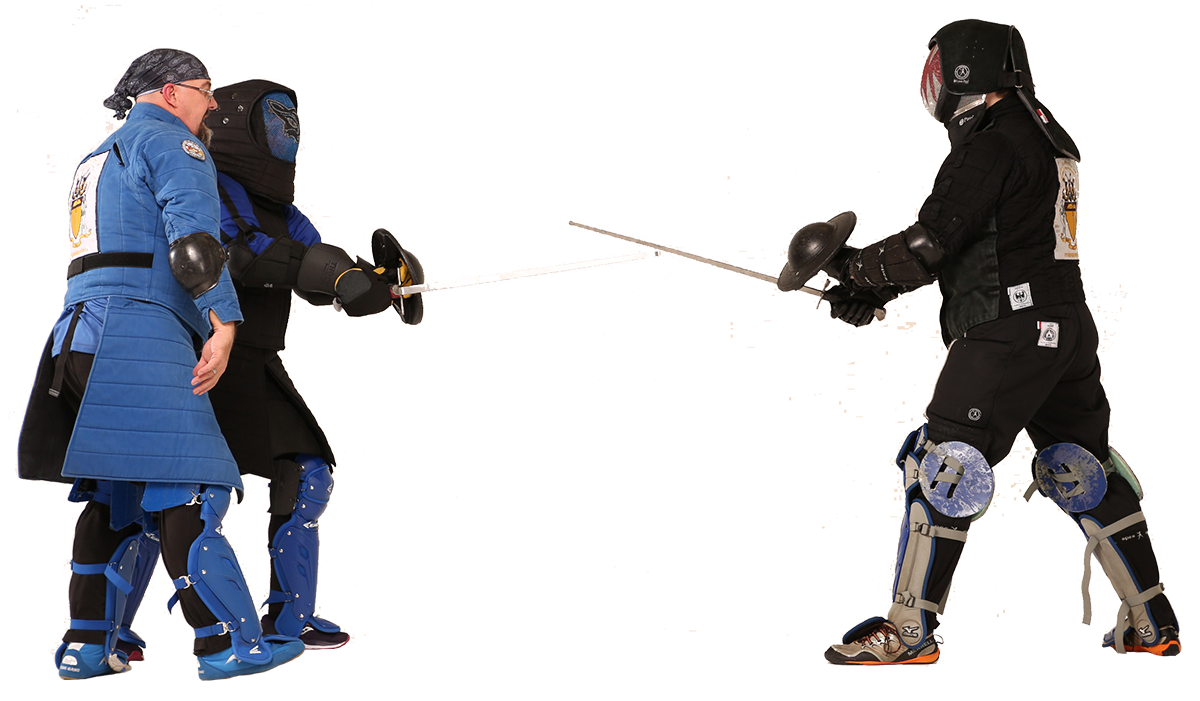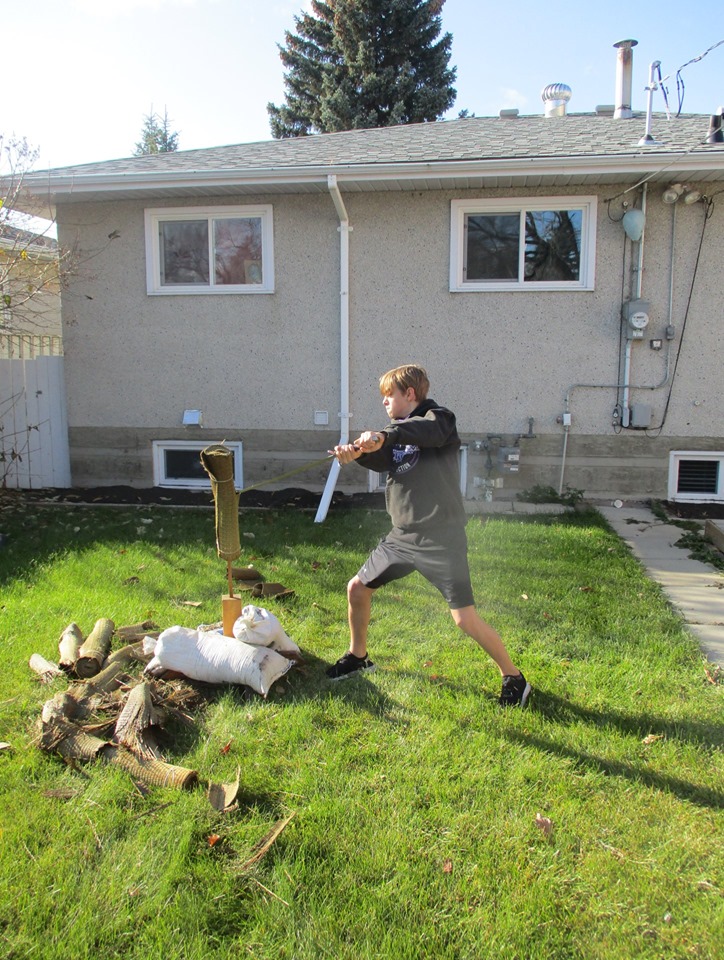
First Swordsmanship class free
Visit us at the Fulton Place Community League any Tuesday at 7:00pm for your first HEMA lesson.
We’ll hand you a sword and we can practice together!
Why Us
We practice the full range of Historical European Martial Arts (HEMA), with a special love given to the sword! Emphasis is placed on effective real-world techniques described in historical arms treatises. You can expect to study all period weapons including pole arms, swords, daggers, and hand-to-hand fighting. While we focus on the teachings of the great masters, Johannes Liecthenauer and Joachim Meyer, we are not afraid to learn from other sources.
If you seek an authentic martial arts experience in an inclusive atmosphere that emphasizes real-world techniques over stage fighting and repetitive forms, look no further than the Academy of European Swordsmanship.
Upcoming Events
From our Blog
Summer Outdoors
Due to the issues with Covid-19 the community halls in Edmonton are shut down for the foreseeable future, so we can’t have indoor classes. However, we are able to have distancing classes outdoors!
Every Tuesday evening, from 6:30 to 8:30 pm throughout July and August we will be having practices at 10770 Winterburn Road. If it’s raining, then practice will be moved to the following Thursday.
We welcome new students!
All classes are by donation – pay what you can. Yes, we still have costs, even though there are no hall rent expenses at the moment. Any help is appreciated!
Safety protocols for the epidemic are in place and will be gone over at the beginning of each class. If you have your own sanitizer and mask, this is appreciated.
Let’s have a safe and fun summer!

Covid-19 Update
Sadly, last week Fulton Place Community League decided to postpone all rentals until further notice. While we agree that this is the safest way to handle the current crisis, we are saddened that it has to be this way.
So, what can we do in the meantime?
- Read… Members, have a look at the resources in the members’ dropbox. There is a LOT there to read, certainly enough to get through a couple of months of isolation. If you are a member and don’t have access to this, please email Johanus and you will be added.
- Practice! Practice your cuts, do movement drills, exercise…
- Watch videos. Some are great, some not-so-much. But you can still learn from them. YouTube is overrun with HEMA videos.
- Chat! Yes, we can talk about this together online. Have a look at The AES Study Hall on Facebook. This is where you can see who members are and start up a chat with someone.
- If you are close enough (and safe from CV-19) you can meet in small groups – 2 to 4 people. The weather is getting nicer and soon you can do this outdoors.
- Write! Work on your scholar projects. There is still a lot to explore in our Western Martial Arts, help yourselves and others by doing some research and writing down what you learn.
What am I doing as an instructor? I am doing all of the above. Yes, I have to be very careful, as I’m one of the vulnerable group, being immunocompromised. The latest news is that between 35% and 70% of people will catch this virus. I can’t be one of them! So, I am writing. I am researching. I am meeting people one-on-one or two at a time (with precautions taken). And, given time, will be releasing some videos that I and other members have recorded earlier for our YouTube channel ( https://www.youtube.com/user/EuropeanSwordmanship ).
Stay safe!
A note for members: your March dues will be applied, on a pro-rated basis, to classes once we begin regularly again. Hopefully soon!

What Makes a Complete Martial Arts System
I recently answered a question on a site called Quora, regarding this. Quora is a site where people post questions for others to answer. It’s one of the most civil discussion sites I’ve ever seen, which is why I like it. Trolling is kept to a minimum, and active, intellectual discussion is encouraged.
Anyhow, here’s the answer: Read Johanus Haidner‘s answer to What makes a martial art a complete system? on Quora
There are tonnes of sources available for Historical European Martial Arts (HEMA) found on the web, and probably the best of these is Wiktenauer.
Hit Data – history vs. today
I had to read this article by Sean Franklin: http://swordstem.com/2019/10/02/historical-injury-vs-modern-tournament-targeting/
It’s fascinating how the data shows so much about targeting in the contexts of the history, versus our tournaments today. Does it have to do with the context of the tournament versus the battlefield? Franklin does address this in his article (read it). I do wonder if that is a big part of it. When fighting in a group, one might imagine that the tactics and movements would be significantly different for people fighting as individuals. What might be interesting to continue this kind of study is to look at and analyse some of the Buhurt battles and see where people are hit first. That would take quite a bit of video analysis and time!


Our Sources and What We Study
HEMA has a wide variety of sources nowadays, unlike when the AES started back in the early 1990’s. We had few resources – the Lichtenauer poem, Talhoffer’s 1467 treatise (only in German), and a few other references that were incomplete. Since then the scholarship in this has expanded greatly!
Today we have people translating treatises and publishing them on a semi-regular basis. There are multiple interpretations of some of the same works. And there are articles and web sources galore. I can’t even imagine what it would be like today if something like Wiktenauer had existed 20 years ago.
There are arguments online about how to do techniques, and what any particular Master meant in the treatises. There are armchair experts in our martial arts now, like in any of the other arts. We can never really understand with 100% certainty everything that any Master meant in their writings, even with the illustrations and the small amount practice we have. Productive sharing of information, however, is a good thing. Outright criticism without feedback is useless to everyone.
We study an art that has been revived. There is no truly continuous chain of swordmasters leading back to the Renaissance, let alone the Middle Ages. Our art died and was resurrected. In the 25 years since the AES was founded we have learned a lot. We’ve passed it on to countless people, very few who had the skill patience to become instructors. Even after teaching for 25 years I feel that I have a lot to learn.
Reading and comparing the various sources as I have, I believe that there are more similarities than differences across them. Whether I’m teaching earlier Masters, like Talhoffer or Ott, or from a later source, like Meyer, the similarities are striking. Later sources have more terminology listed. My theory is that this was to give more subtle differentiation on techniques that were often grouped under the same term in earlier periods.
When working with instructors who teach from the Italian tradition, such as Fiore, versus the German sources that I primarily use, I’ve found that they tend to teach mostly the same techniques, but using different names – Italian ones, of course. This leads me to believe that it’s a good thing to read and understand a variety of sources, as that can give clearer and more complete understanding of any given technique, and our Western Martial Arts (or, if you prefer, Historical European Martial Arts) overall.